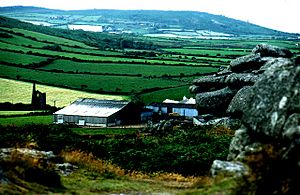Trencrom Hill facts for kids
|
Trecrobben
|
|

View NW from Trencrom Hill
|
|
| Lua error in Module:Location_map at line 420: attempt to index field 'wikibase' (a nil value). | |
| Location | Cornwall |
|---|---|
| Type | Tor enclosure Hill fort |
| History | |
| Periods | Neolithic Iron Age |
Trencrom Hill (also called Trecrobben) is a famous ancient site in Cornwall, England. It's owned by the National Trust, a charity that protects special places. At the top of the hill, you can find the remains of an old tor enclosure from the Neolithic period (New Stone Age). Later, during the Iron Age, it was used as a hillfort.
You can still see signs of old cairns (piles of stones) or hut circles (places where ancient homes stood) on the flat area inside the stone and earth walls. From the hill, you get amazing views of the Hayle Estuary and Mount's Bay, including St Michael's Mount. The name "Trencrom" comes from the Cornish words "torr crobm," which means 'hunched bulge.'
Trink Hill is another nearby hill, about one kilometre to the northwest.
Caring for Trencrom Hill
The National Trust took ownership of Trencrom Hill in 1946. It was given to them by Lieutenant Colonel G L Tyringham. As you walk up the north side of the hill, you'll find a special plaque carved into a rock.
This plaque says: "This property was presented to the National Trust by Lt Col C L Tyringham, of Trevethoe in March 1946 & at his wish is to be regarded as a memorial to the men and women of Cornwall, who gave their lives in the service of their country during the two world wars. 1914 – 1918, 1939 – 1945"
This means the hill is a special place to remember the brave people from Cornwall who died helping their country in World War I and World War II.
There's a well on the west side of the hill's old walls, known as the Giant's Well. An old writer named James Halliwell-Phillipps mentioned it in 1861. He wrote that it was "Outside the vallum at Trecrobben." There's another well lower down on the eastern side, but that one is actually an old, unused mining shaft, not the Giant's Well.
Mining History at Trencrom
For a while, people tried to mine for valuable minerals like tin around Trencrom Hill. The area, known as Wheal Cherry (later New Trencrom Mine), included the top of the hill.
Mining attempts here were not very successful. In the mid-1800s, a lot of money was spent on equipment, but the mine was soon offered for sale. There were other attempts in the early 1900s and even in 1943, but they didn't find much tin.
People also quarried stone from the hill. A survey in 1996 found signs of small quarries. It seems parts of the granite summit were flattened, and a paved path might have been used to move the stone away.
Giants and Legends
Trencrom Hill has its own exciting legend about a giant named Trecobben. The story says that Trecobben killed Cormelian, who was the wife of another giant named Cormoran. He did this by throwing a hammer all the way from Trencrom Hill to St Michael's Mount!

